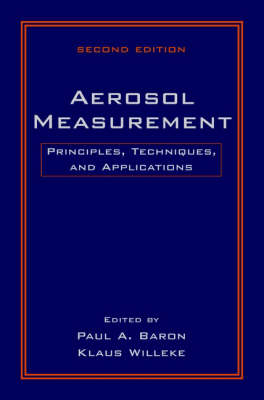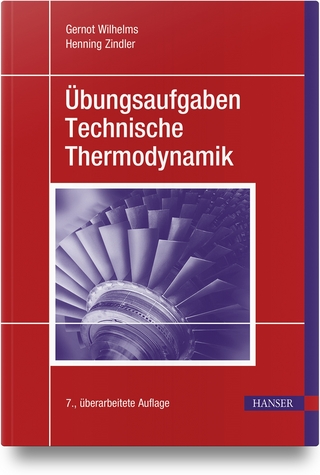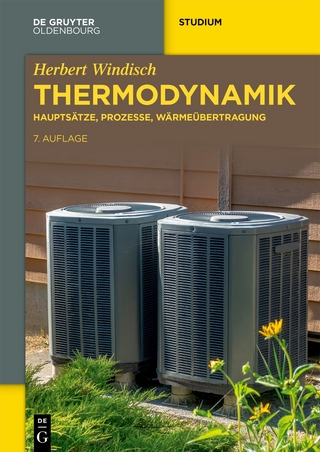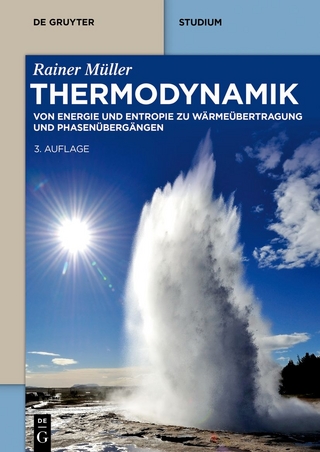
Aerosol Measurement
John Wiley & Sons Inc (Verlag)
978-0-471-35636-3 (ISBN)
- Titel erscheint in neuer Auflage
- Artikel merken
In recent years, industry has become increasingly interested in modern aerosol measurement methods, not only to protect the health of their workers but also to augment productivity and thereby gain competitive advantage. "Aerosol Measurement: Principles, Techniques, and Applications, Second Edition" offers scientists and practitioners the fundamental principles used in deciding which aerosol properties to measure and how to interpret the results. Divided into three parts, the material reviews the physical understanding of aerosols, covers specific instrumental techniques, and explains applications in fields ranging from health care to mining and upper-atmosphere research. Leading experts contribute to the review of such areas as direct-reading techniques, bioaerosol sampling, indoor air evaluations, industrial aerosol processing, and measurement in semiconductor clean rooms. Plus, all the chapters in this latest edition have been updated and some have been rewritten by new authors. Two new chapters have been added: one on historical aspects of aerosol measurements and the other on real-time single particle analysis.
Klaus Willeke, Ph. D., was trained in Aeronautics and Astronautics at Stanford University and has been a Professor of Environmental Health at the University of Cincinnati since 1981. He has authored or co-authored over 100 journal publications on the physical and biological aspects of aerosol generation, sampling and analysis. Several of the concepts generated in his Aerosol Research and Exposure Assessment Laboratory have been incorporated into commercially available instruments. He is a consultant to major US companies and has lectured widely in America, Europe and Asia. About 30 scientists from other institutions have spent a year or more with him and his international team of researchers. Paul A. Baron, Ph.D., is a Physical Scientist at the National Institute for Occupational Safety and Health, Physical Sciences and Engineering Division. Currently a member of the Board of Directors of the American Association for Aerosol Research and Associated Editor of the Aerosol Science and Technology Journal, Dr. Baron has authored or co-authored over 60 publications involving fiber measurement or other aspects of aerosol science. The Outstanding Aerosol Paper Award from the Aerosol Technology Committee of the American Industrial Hygiene Association was awarded to Dr. Baron in 1990 and 1993 and to Dr. Willeke in 1993 in 1993; they received the award jointly in 1992.
Preface. List of Principal Symbols. Contributors. PART I: PRINCIPLES. Historical Aspects of Aerosol Measurements (K. Spurny). Bridging Science and Application in Aerosol Measurement: Accessing Available Tools (P. Baron and K. Willeke). Aerosol Fundamentals (P. Baron and K. Willeke). Gas and Particle Motion (P. Baron, K. Willeke). Physical and Chemical Changes in the Particulate Phase (W. Hinds). Size Distribution Characteristics of Aerosols (W. John). An Approach to Performing Aerosol Measurements (P. Baron and W. Heitbrink). PART II: TECHNIQUES. Sampling and Transport of Aerosols (J. Brockmann). Filter Collection (K. Lee and R. Mukund). Inertial Gravitational, Centrifugal and Thermal Collection Techniques (V. Marple, et al.). Chemical Analysis Methods for Atmospheric Aerosol Components (P. Solomon, et al.). Analysis of Individual Collected Particles (R. Fletcher, et al.). Real--Time Single--Particle Analysis (A. Wexler and M. Johnston). Dynamic Mass and Surface Area Measurements (U. Baltensperger, et al.). Optical Direct--Reading Techniques: Light Intensity Systems (J. Gebhart). Optical Direct--Reading Techniques: In Situ Sensing (D. Rader and T. O'Hern). Direct--Reading Techniques Optical Particle Motion and Optical Detection (P. Baron, et al.). Electrical Techniques (R. Flagan). Condensation Detection and Diffusion Size Separation Techniques (Y.--S. Cheng). Electrodynamic Levitation of Particles (E. Davis). Instrument Calibration (B. Chen and W. John). Methods of Size Distribution Data Analysis and Presentation (D. Cooper). PART III: APPLICATIONS. Nonspherical Particles Measurement: Shape Factors, Fractals, and Fibers (P. Baron, et al.). Biological Particle Sampling (T. Reponen, et al.). Aerosol Measurement in the Workplace (A. Maynard and P. Jensen). Mine Aerosol Measurement (B. Cantrell and J. Volkwein). Ambient Air Sampling (J. Watson and J. Chow).Fugitive Dust Emissions (C. Cowherd). Indoor Aerosols and Aerosol Assessment (C. Rodes and R. Wiener). Measurement of Aerosol from Aircraft (J. Wilson and W. Seebaugh). Measurement of High--Concentration and High--Temperature Aerosols (P. Biswas). Manufacturing of Materials by Aerosols Processes (S. Pratsinis, et al.). Aerosol Measurements in Cleanrooms (R. Donovan). Radioactive Aerosols (M. Hoover and G. Newton). Radon and Its Short--Lived Decay Product Aerosols (B. Cohen). Aerosol Measurement of Pharmaceutical and Diagnostic Aerosols (A. Hickey and D. Swift). Inhalation Toxicology: Sampling Strategies Related to Control of Exposure Atmospheres (O. Moss). Appendix A: Glossary of Terms. Appendix B: Conversion Factors. Appendix C: Commonly Used Constants. Appendix D: Some Properties of Air and Water. Appendix E: Major Dimensionless Numbers. Appendix F: Properties of Particles. Appendix G: Geometric Formulas Appendix H: Bulk Density of Some Common Aerosol Materials. Appendix I: Manufacturers and Suppliers. Index.
| Erscheint lt. Verlag | 19.11.2001 |
|---|---|
| Zusatzinfo | index |
| Verlagsort | New York |
| Sprache | englisch |
| Maße | 189 x 260 mm |
| Gewicht | 1928 g |
| Einbandart | gebunden |
| Themenwelt | Naturwissenschaften ► Physik / Astronomie ► Thermodynamik |
| ISBN-10 | 0-471-35636-0 / 0471356360 |
| ISBN-13 | 978-0-471-35636-3 / 9780471356363 |
| Zustand | Neuware |
| Informationen gemäß Produktsicherheitsverordnung (GPSR) | |
| Haben Sie eine Frage zum Produkt? |
aus dem Bereich



